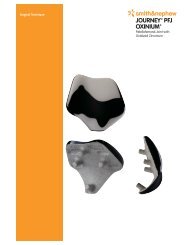Uni- Condylar Knee Surgical Technique - Yorkshire Joint ...
Uni- Condylar Knee Surgical Technique - Yorkshire Joint ...
Uni- Condylar Knee Surgical Technique - Yorkshire Joint ...
Create successful ePaper yourself
Turn your PDF publications into a flip-book with our unique Google optimized e-Paper software.
Tibial Jig Alignment<br />
Resection Level<br />
Goal: Remove the entire tibial defect with the<br />
minimum amount of resection necessary to<br />
restore the joint line.<br />
A: Non-slotted stylus foot<br />
When using the cutting slot, position the foot of<br />
the tibial stylus marked “slotted” into the slot of<br />
the tibial cutting block (Figure 10). When resecting<br />
on top of the cutting block, place the foot marked<br />
“open” into the cutting slot (Figure 10, A). Bring<br />
the tip of the stylus to rest on the tibial plateau<br />
and set depth accordingly.<br />
The final resection level can be dialed in by<br />
rotating the fine-tune mechanism clockwise<br />
(upward adjustment) or counterclockwise<br />
(downward adjustment) (Figure 10, B). Care<br />
should be taken with severe valgus deformity not<br />
to over-resect the tibia.<br />
B: Fine tune adjustment<br />
After the height has been set, stabilise the block<br />
with one pin.<br />
Note: When the resection level is in question,<br />
under-resect. A second tibial cut is preferable to<br />
an overly aggressive first cut.<br />
Figure 10<br />
Pin placement is per surgeon preference, but<br />
typically one pin is for alignment, one pin for<br />
stabilisation after the resection level is determined<br />
and one pin for the L-cut. (Figure 11).<br />
Figure 11<br />
6





